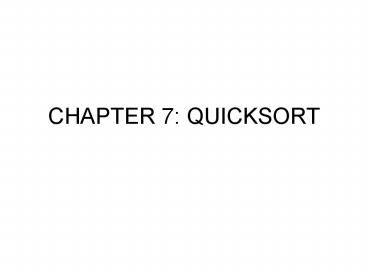CHAPTER 7: QUICKSORT - PowerPoint PPT Presentation
1 / 15
Title:
CHAPTER 7: QUICKSORT
Description:
Quicksort, like merge sort, is based on the divide-and-conquer paradigm(??) ... on the running time of quicksort, where we have replaced T(n) by n for convenience. ... – PowerPoint PPT presentation
Number of Views:109
Avg rating:3.0/5.0
Title: CHAPTER 7: QUICKSORT
1
CHAPTER 7 QUICKSORT
2
- Quicksort is a sorting algorithm whose worst-case
running time isT(n2) on an input array of n
numbers. In spite of this slow worst-case running
time, quicksort is often the best practical
choice for sorting because it is remarkably
efficient on the average its expected running
time is T(n lg n), and the constant factors
hidden in theT(n lg n) notation are quite small.
It also has the advantage of sorting in place,
and it works well even in virtual memory
environments.
3
7.1 Description of quicksort
- Quicksort, like merge sort, is based on the
divide-and-conquer paradigm(??). - Divide The array Ap . . r is partitioned
(rearranged) into two nonempty subarrays Ap . .
q and Aq 1 . . r such that each element of
Ap . . q is less than or equal to each element
of Aq 1 . . r. - Conquer The two subarrays Ap . . q and Aq 1
. . r are sorted by recursive calls to
quicksort. - Combine Since the subarrays are sorted in place,
no work is needed to combine them the entire
array Ap . . r is now sorted.
4
- QUICKSORT(A,p,r)
- 1 if p lt r
- 2 then q?PARTITION(A,p,r)
- 3 QUICKSORT(A,p,q)
- 4 QUICKSORT(A,q 1,r)
- PARTITION(A,p,r)
- 1 x?Ar
- 2 i?p - 1
- 3 for j?p to r-1
- 4 do if Ajx
- 5 then i?i1
- 6 exchange Ai ?Aj
- 7 exchange Ai1 ?Ar
- 8 return i1
- The running time of PARTITION on the subarray
Ap..r is T(n), where nr-p1.
5
(No Transcript)
6
PARTITIONs loop invariant
- At the beginning of each iteration of the loop of
lines 3-6, for any array index k, - If pki, then Akx.
- If i1kj-1, then Akgtx.
- If kr, then Akx.
7
7.2 Performance of quicksort
- The running time of quicksort depends on whether
the partitioning is balanced or unbalanced, and
this in turn depends on which elements are used
for partitioning. If the partitioning is
balanced, the algorithm runs asymptotically as
fast as merge sort. If the partitioning is
unbalanced, however, it can run asymptotically as
slow as insertion sort.
8
Worst-case partitioning
- The worst-case behavior for quicksort occurs when
the partitioning routine produces one region with
n - 1 elements and one with 0 element. Let us
assume that this unbalanced partitioning arises
at every step of the algorithm. Since
partitioning costsT(n) time and T(0) T(1), the
recurrence for the running time is - T(n) T(n - 1) T(n).
9
Best-case partitioning
- If the partitioning procedure produces two
subproblems each of size no more than n/2. In
this case, quicksort runs much faster. The
recurrence is then - T(n) 2T(n/2) T(n),
- which by case 2 of the master theorem (Theorem
4.1) has solution T(n)T(n lg n). Thus, this
best-case partitioning produces a much faster
algorithm.
10
Balanced partitioning
- The average-case running time of quicksort is
much closer to the best case than to the worst
case. The key to understanding why this might be
true is to understand how the balance of the
partitioning is reflected in the recurrence that
describes the running time. - Suppose, for example, that the partitioning
algorithm always produces a 9-to-1 proportional
split. We then obtain the recurrence - T(n) T(9n/10) T(n/10) n
- on the running time of quicksort, where we
have replaced T(n) by n for convenience.
11
(No Transcript)
12
Intuition for the average case
- In the average case, PARTITION produces a mix of
"good" and "bad" splits. In a recursion tree for
an average-case execution of PARTITION, the good
and bad splits are distributed randomly
throughout the tree. Suppose for the sake of
intuition, however, that the good and bad splits
alternate levels in the tree, and that the good
splits are best-case splits and the bad splits
are worst-case splits.
13
- (a) Two levels of a recursion tree for quicksort.
The partitioning at the root costs n and produces
a "bad" split two subarrays of sizes 0 and n -
1. The partitioning of the subarray of size n - 1
costs n - 1 and produces a "good" split two
subarrays of size (n - 1)/2. (b) A single level
of a recursion tree that is worse than the
combined levels in (a), yet very well balanced.
14
7.3 Randomized versions of quicksort
- RANDOMIZED-PARTITION(A,p,r)
- 1 i?RANDOM(p,r)
- 2 exchange Ar ?Ai
- 3 return PARTITION(A,p,r)
- RANDOMIZED-QUICKSORT(A,p,r)
- 1 if p lt r
- 2 then q?RANDOMIZED-PARTITION(A,p,r)
- 3 RANDOMIZED-QUICKSORT(A,p,q)
- 4 RANDOMIZED-QUICKSORT(A,q 1,r)
15
Homework
- 7.1-4, 7.2-5.































